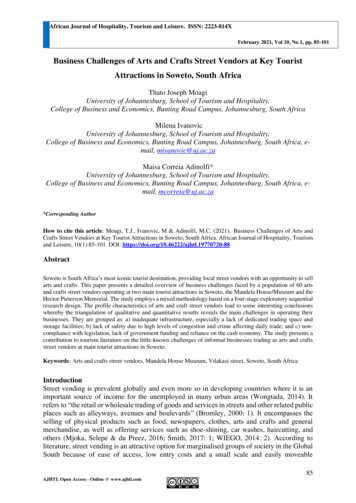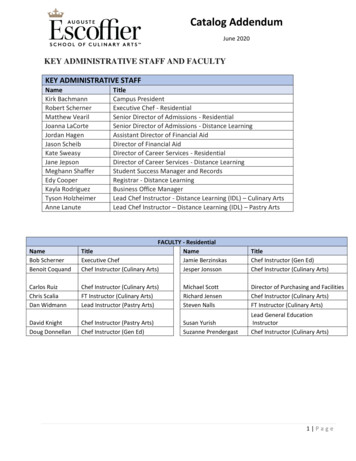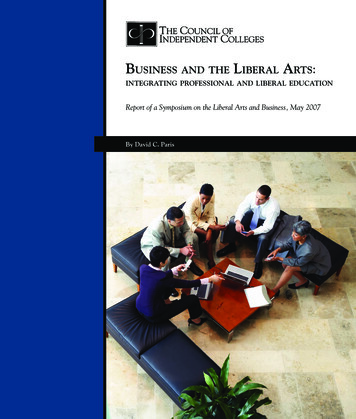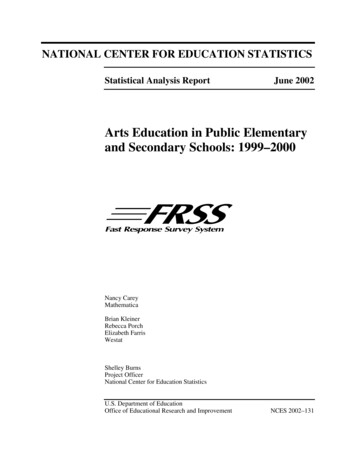
Transcription
African Journal of Hospitality, Tourism and Leisure. ISSN: 2223-814XFebruary 2021, Vol 10, No 1, pp. 85-101Business Challenges of Arts and Crafts Street Vendors at Key TouristAttractions in Soweto, South AfricaThato Joseph MoagiUniversity of Johannesburg, School of Tourism and Hospitality,College of Business and Economics, Bunting Road Campus, Johannesburg, South AfricaMilena IvanovicUniversity of Johannesburg, School of Tourism and Hospitality,College of Business and Economics, Bunting Road Campus, Johannesburg, South Africa, email, mivanovic@uj.ac.zaMaisa Correia Adinolfi*University of Johannesburg, School of Tourism and Hospitality,College of Business and Economics, Bunting Road Campus, Johannesburg, South Africa, email, mcorreia@uj.ac.za*Corresponding AuthorHow to cite this article: Moagi, T.J., Ivanovic, M & Adinolfi, M.C. (2021). Business Challenges of Arts andCrafts Street Vendors at Key Tourist Attractions in Soweto, South Africa. African Journal of Hospitality, Tourismand Leisure, 10(1):85-101. DOI: Soweto is South Africa’s most iconic tourist destination, providing local street vendors with an opportunity to sellarts and crafts. This paper presents a detailed overview of business challenges faced by a population of 60 artsand crafts street vendors operating at two main tourist attractions in Soweto, the Mandela House/Museum and theHector Pieterson Memorial. The study employs a mixed methodology based on a four-stage exploratory sequentialresearch design. The profile characteristics of arts and craft street vendors lead to some interesting conclusionswhereby the triangulation of qualitative and quantitative results reveals the main challenges in operating theirbusinesses. They are grouped as: a) inadequate infrastructure, especially a lack of dedicated trading space andstorage facilities; b) lack of safety due to high levels of congestion and crime affecting daily trade; and c) noncompliance with legislation, lack of government funding and reliance on the cash economy. The study presents acontribution to tourism literature on the little-known challenges of informal businesses trading as arts and craftsstreet vendors at main tourist attractions in Soweto.Keywords: Arts and crafts street vendors, Mandela House Museum, Vilakazi street, Soweto, South AfricaIntroductionStreet vending is prevalent globally and even more so in developing countries where it is animportant source of income for the unemployed in many urban areas (Wongtada, 2014). Itrefers to “the retail or wholesale trading of goods and services in streets and other related publicplaces such as alleyways, avenues and boulevards” (Bromley, 2000: 1). It encompasses theselling of physical products such as food, newspapers, clothes, arts and crafts and generalmerchandise, as well as offering services such as shoe-shining, car washes, haircutting, andothers (Mjoka, Selepe & du Preez, 2016; Smith, 2017: 1; WIEGO, 2014: 2). According toliterature, street vending is an attractive option for marginalised groups of society in the GlobalSouth because of ease of access, low entry costs and a small scale and easily moveable85AJHTL Open Access - Online @ www.ajhtl.com
African Journal of Hospitality, Tourism and Leisure, Volume X (X) - (2020) ISSN: 2223-814XCopyright: 2020 AJHTL /Author(s) Open Access – Online @ www.ajhtl.combusinesses (Bromley, 2000; Brown, Lyons & Dankoco, 2010: 672; Crush, Skinner &Chikanda, 2015: 43; Nkrumah-Abebrese & Schachtebeck, 2017: 130; Nyawo & Mubangizi,2015: 4; Pavani, 2017: 198). Street vending forms part of a larger informal or second economycomprising of unregistered and non-taxpaying businesses, making it difficult to determine itssize (Adegoke, 2019; Rogan & Skinner, 2019). The International Labour Organisation (ILO,2018) estimates that over 60% of the world’s employed population falls within the informaleconomy, while in Africa, that figure stands at 85.8%. Interestingly Medina, Jonelis and Cangul(2017) estimate that the informal sector in South Africa, known as the cash or second economy,features on the lower end, between 20-25% of the total economy.The second economy is a legacy of apartheid, mostly prevalent in South Africantownships, which were created not as economic hubs, but as dormitories for cheap unskilledlabourers unemployable in the formal economy in the nearby towns (Grant, 2013: 91; Naidoo,2018; Mashaba, 2017). As such, the economy in the townships remained underdeveloped, withweak infrastructure, resulting in the growth of informal businesses, with street vending, as animportant source of income for many townships (Charman, Petersen & Govender, 2020).Charman, Petersen and Govender (2020: 65-66) provide valuable insight into theeconomies of several townships across South Africa. Their research reveals that street trademakes up the highest proportion of micro-enterprises on the high streets of the townships whilearts and crafts, in particular, make up the highest proportion of micro-enterprises in theresidential areas of the townships surveyed. Interestingly, Vilakazi Street in Soweto can beconsidered a ‘high street’ with its extensive foot and vehicle traffic. In Soweto, tourismactivities have attracted specialised arts and crafts street vendors that have strategically placedtheir informal businesses outside main tourist attractions and along Vilakazi Street (De Run,2012: 245). Despite arts and crafts street vendors playing a significant role in Soweto’s tourismeconomy, an extensive review of the literature revealed that so far, they have not received anyresearch attention. Thus, a look into the challenges of arts and crafts street vendors can providea unique understanding of what they face on the ground. This paper aims to present the profilecharacteristics and business challenges of arts and crafts street vendors at two key touristattractions in Soweto, South Africa. The literature overview that follows provides an insightinto the characteristics of street vending in Africa, which proved common to many countriesacross the continent, followed by a discussion of specific characteristics of street vending inSouth Africa.Street vending in AfricaWith such a high proportion of the economy being related to informal businesses in Africa(ILO, 2018), it is regarded as a ‘major force’ on the continent (Graaff & Ha, 2015: 4; Little,2002: 62; Rogerson, 2018: 381). Street vending accounts for between 2 and 24% of total urbaninformal employment in African, Asian and Latin American cities (Roever, 2014). Streetvending in Africa is perceived as an occupation for those with a considerably low-income leveland tend to be ‘survivalist’ in nature (Charman, Petersen & Govender, 2020; Forkuor, Akuoko& Yeboah, 2017). Other characteristics that typify street vending within the context of theinformal economy include low levels of education and lack of employment opportunities in theformal economy (Grabrucker, Grimm & Roubaud, 2018). African street vendors face severalchallenges when operating their businesses, as opposed to their North American and Europeancounterparts where governments closely administer and regulate street vending (Csapo, 2011;Graaff & Ha, 2015: 4; Hochberg, 2017; Liu, Burns & Flaming, 2015: 2). A summary ofcountry-specific African street vendors’ main business challenges is presented in Table 1below.86
African Journal of Hospitality, Tourism and Leisure, Volume X (X) - (2020) ISSN: 2223-814XCopyright: 2020 AJHTL /Author(s) Open Access – Online @ www.ajhtl.comTable 1: Business challenges of street vending in AfricaFactorLack ofinfrastructure Not beingincorporated intogovernment plansand/or notregulated Harassment bymunicipalauthorities and thepolice Low valueproducts and lackof access tofunding IndicatorsTemporary use of weak, unstable tentsStalls cannot withstand the rough weatherconditionsLack of mobile toilets, sanitation, hanisms for productsStock/products get damaged because of badweatherBad working conditions have a negative effecton people’s healthStreet vendors are marginalised or notincluded in government plans, andgovernments are not accommodating thestreet vendors’ needs into their decisionmaking processesThe majority of street vendors in Africancities operate at unofficial places which arenot regulated and controlledLaws that do not support street vendingEconomic instabilityPressure groups, and NGO’s that are allinclusive of the private sector do not supportthe street vendorsPolitical disputesBribery, ‘informal’ daily taxes paid tomunicipal authorities and police officersStreet vendors harassed or often chased awayfrom locations.Street vendors considered a threat to image ofan area.Street vendors selling relatively low valueproducts such as sweets, snacks and smalljewelleryStreet vendors working more hours togenerate more income, but still make verylittle moneyLack of funds as they cannot providecollateral security to get bank loansCountry and key referencesEgypt & Tunisia: Brown,Kafafy & Hayder (2017);Dreisbach & Smadhi (2014);Ghana: Acquah (2013);Ahenpon (2015); Crush,Skinner & Chikanda (2015);Samuel & Mintah (2013).Zambia: Foukuor et al,(2017); Muuka (2003).Uganda: Akharuzzaman &Deguchi (2010); Muyanja,Nayiga, Brenda & Nasinyama(2011).Kenya: Mitullah (2003);Muinde & Kuria (2005).Zimbabwe: Crush, Skinner &Chikanda (2015); King(2006).Kenya, Cote d’Ivoire,Ghana, Zimbabwe, Uganda:Mitullah (2003)Lesotho: Morley (2018).Zimbabwe: Ndiweni &Verhoeven (2013).However, it is important to note that even though each country has its own challengesdepending on the country’s legislation, organisation of street vending, and overarchingeconomic conditions, these challenges are common to most countries in Africa, includingSouth Africa.Street vending in South AfricaAlthough street vending has received some research attention in South Africa, little to noresearch is available on Soweto's street vendors and in particular, its arts and crafts streetvendors. Thus, the literature available on street vending has mostly been focused on majorcities such as Johannesburg (Bénit-Gbaffou, 2018a, 2018b; Rogerson, 2015), Durban (Roever,2016; Sidzatane & Maharaj, 2013, Skinner, 2008) and Cape Town (Sassen, Galvaan & Duncan,2018; van Heerden, 2011). Accurate information is lacking of the relative size and compositionof street vending in South Africa (Roever & Skinner, 2016). According to Gamieldien & vanNiekerk (2017: 25), street vending contributes 7% to the national Gross Domestic Product(GDP) in South Africa and generates 22% of total employment in the country. In the fourthquarter of 2019, StatsSA (2019) reported that the informal sector employed over 2.9 million87
African Journal of Hospitality, Tourism and Leisure, Volume X (X) - (2020) ISSN: 2223-814XCopyright: 2020 AJHTL /Author(s) Open Access – Online @ www.ajhtl.compeople, of which just over 1.1 million were counted as informal traders, which includes streetvendors. The South African street vendors face similar challenges as their African colleagues,the main being infrastructure (Dierwechter, 2004; Foukuor et al., 2017; Gamieldien & VanNiekerk, 2017; Soloman, Sylvana & Decardi, 2011; Timalsina, 2011; Willemse, 2011), safety(City of Johannesburg, 2009, 2010; Matjomane, 2013; WIEGO, 2014), and a weak legislativeenvironment (Peberdy, 2000; Yatmo, 2009). Street vending in South Africa is regulated by theBusiness Act (71 of 1991), which grants municipal authorities the power to prescribe licensesas a requirement for street vending (Forkuor et al., 2017: 8; WIEGO, 2014). Governing andregulating the environments where street vendors operate proved to be a challenge for therelevant municipal authorities, due to a lack of proper recording systems to capture theactivities that occur in the informal sector (Forkuor et al., 2017: 4; Timalsina, 2011: 8; Yatmo,2009: 468).There are, however, non-governmental organisations that assist street vendors tocombat their challenges and ‘voice’ the problems they face to relevant authorities in the hopeof getting assistance. The Pretoria Informal Business Association (PIBA), the Green PointTraders Association in Cape Town, the Cape Town Deck Traders Association, StreetNet, theSouth African National Traders Retail Alliance (SANTRA), Kliptown Hawkers Associationand the South African Informal Traders’ Alliance (SAITA) are examples of such, with somehaving offices in Soweto (Mitullah, 2003: 13; WIEGO, 2014). Although there is not muchattention paid to the role of these organisations in academic literature, Bénit-Gbaffou (2014,2016) investigates the role, perceptions of value, and politics surrounding these associations.The author describes how they are often ignored or not taken seriously but have played animportant role in identifying and resolving injustices towards street vendors. Thus, streetvendors face major challenges that affect their survival and day-to-day operations and arelinked to several factors, including the political landscape and governance of informaleconomic activities. A greater understanding of these experiences in specific populations ofstreet vendors can contribute to a wider comprehension of the importance of the informalsector. Thus, this paper seeks to present the characteristics and experiences of a specificpopulation of arts and crafts street vendors that not only contribute to the economy of Soweto,Gauteng and South Africa but more importantly form part of a wider tourism economy that hasproven to be crucial to the country’s economic growth.MethodologyThe study made use of a mixed-method sequential research design (qualitative-quantitative)consisting of three phases, represented in Figure 1:Figure 1: Three-phased mixed-method sequential research design88
African Journal of Hospitality, Tourism and Leisure, Volume X (X) - (2020) ISSN: 2223-814XCopyright: 2020 AJHTL /Author(s) Open Access – Online @ www.ajhtl.comThe first phase involved qualitative data collection by means of open-ended, semistructured interviews with n 10 randomly selected arts and crafts street vendors, 2 that operateat the Hector Pieterson Museum and Memorial and 8 at The Mandela House Museum. Theinterviews were tape recorded and analysed by Thematic Content Analysis, and three themeswere identified: (1) Infrastructure, (2) Safety, and (3) Legislation and government support. Theresults of the first phase informed the development of the questionnaire and are presented inTable 2 below:Table 2: Results of thematic content analysis of 10 semi-structured interviewsQuestionsEmerging themesGeneral demographics of interviewedarts and crafts street vendors Q1. Who are the arts and crafts streetvendors’ customers?Q2 and Q3. Types of products the artsand crafts street vendors sell Q4. Relationship between arts andcrafts street vendors and surroundingattractions, organisations and tourguides.Q5. Location of the businesses Q6. Relationship amongstemployee/employersQ7. Handling of money/cash for thebusinessQ8. General operation & businesspractice Q9. Legislative environment Average age is 41 years old90% breadwinners in their householdsRespondents have no educationHighly dependent on current occupation as that is the only income theyreceiveAll respondents are self-employedCustomers and target market are mostly international touristsLanguage barrier not an issueThey mostly make their own products like wooden crafts, beaded work,paintings and products made from sand.Other products stocked included shirts, caps, scarves and stone art.They charge international customers higher (double) than local customersSell what tourists want and are not influenced by other street vendorsRegular stock-taking conducted by all street vendors which helps themdecide what to sellTour guides do not refer tourists to arts and crafts street vendorsNo relationships between street vendors and surrounding attractionsStreet vendors do not pay rent to municipal authoritiesSome street vendors pay homeowners to operate on their pavementCrime high at location. Safety an issue.Street vendors would not move elsewhere, location too important to themMost street vendors operate almost every day, operating times similar tosurrounding attractions opening/closing times.All street vendors work for themselves and work alone.They receive no training whatsoeverOnly cash exchangesNo proper facilities-speed pointsAcceptance of foreign currencies by all street vendorsStreet vendors want to open more stalls in same locationAll street vendors suggest business not lucrative but for survival purposesonlyToo many risks to become a street vendor at location (safety)Do not advertise their products/businessDo not set any targets for salesStorage of products a problemWeather an issueTransportation of products a challengeLicense needed but street vendors do not have one/ do not know where toget it and costs involvedStreet vendors lack information about legislative environment theyoperate inStreet vendors do not know of any laws to followPolice and municipal authorities do not conduct checks/ do not hasslestreet vendorsThe above findings from the semi-structured interviews informed the development ofthe comprehensive questionnaire, which measured the following variables: a) weather, b)safety, c) operational challenges faced by street vendors (storage; transportation; foreigncurrencies; foreign languages; tour guides), and d) the legislative environment. The first section(A) of the questionnaire consisted of 21 items, focusing on the profile characteristics of artsand crafts vendors (gender, age, nationality, education levels, where they reside at, if they are89
African Journal of Hospitality, Tourism and Leisure, Volume X (X) - (2020) ISSN: 2223-814XCopyright: 2020 AJHTL /Author(s) Open Access – Online @ www.ajhtl.comthe main breadwinners in their households, the number of dependents they have, the amountof money they need monthly to sustain their dependents, and whether that is the only incomethey receive). The first section also contained the background information regarding theirproducts and the way they operate their businesses (i.e. what they sell, which product they sellthe most, who their customers are, and how they handle their stock). The second section (B)consisted of 12 items on a 1-5 Likert-scale (strongly disagree to strongly agree) exploring themain legislative environment, operational issues and ensuing challenges facing arts and craftsstreet vendors at main tourist attractions in Soweto. The questionnaire was piloted on 16th ofJune 2018. Traders were randomly approached one by one until a total of 5 agreed to answerthe questions (8% of the population). After minor changes, the main questionnaire was handedout and completed between 20 June and 20 July 2018 by the entire permanent population ofN 60 arts and crafts street vendors that operate at the Hector Pieterson Museum and Memorial,and Vilakazi Street. Following data analysis, the results informed the third phase where semistructured interviews were conducted with two key organisations, namely: the Vilakazi StreetTourism Association (VISTA) and the Gauteng Enterprise Propeller (GEP). In addition, threefollow-up interviews with the longest running vendors were conducted to confirm theinformation obtained from the three phases.Area of study: SowetoSoweto spans 200 square kilometres with a population of approximately 1.70 million peopleas of 2019 (Worldometer, 2019), thus having a population density of approximately 8 500people per square kilometre. It is the largest township in South Africa in terms of size andpopulation stemming from its servicing of the biggest gold mines in and around Johannesburg(Grant, 2013: 90; Joburg Archive, 2008). The 1976 Soweto uprising made Soweto theinternational symbol of the fight for liberation against oppression and racial segregation duringapartheid. Thus, the Hector Pieterson Museum and Memorial, and the Mandela House Museumhave elevated Soweto as a must-see South African destination especially for internationaltourists seeking to learn more about the country’s political history (Ivanovic, 2008; Mkhize &Ivanovic, 2019: 998). The geographical position of Soweto as the study area is presented inFigure 2 below.Figure 2: Map of Soweto with two selected sites (Source: AfriGis, 2019)90
African Journal of Hospitality, Tourism and Leisure, Volume X (X) - (2020) ISSN: 2223-814XCopyright: 2020 AJHTL /Author(s) Open Access – Online @ www.ajhtl.comAt the time the research was carried out 49 arts and crafts street vendors were operatingat Vilakazi Street where the Nelson Mandela Museum is situated and 11 were outside theHector Pieterson Museum and Memorial. They were selling beaded work (necklaces,wristbands, bracelets, belts, headbands, and sandals); wooden crafts (jewellery boxes, masks,and plates); paintworks; products created from clay, sand, stone and metal; books and DigitalVideo Discs (DVDs), as well as shirts, caps, beanies, and tablecloths. Most of these streetvendors sell a combination of different arts and crafts, apart from a few specialized streetvendors that sell only one product.Results and discussionDemographic characteristics of street vendorsThe demographic results related to gender, age, nationality, education, and number ofdependants of the whole population (N 60) are presented in Table 3 below. The demographicresults of arts and crafts street vendors provide the most valuable insight into unique profilecharacteristics of specialised tourism orientated street vendors at main tourist attractions inSoweto.Interestingly, the results indicate an equal distribution with regards to gender, and themajority (90%) of the street vendors surveyed, being South African. This contrasts with otherstudies where women dominate street vending (Roever, 2014; Roever & Skinner, 2016). Thepresence of foreign nationals in the street vending activities is common in South Africaespecially in Johannesburg (Grant & Thompson, 2015). However, the two sites in Soweto donot seem to reflect these characteristics as only 6 vendors out of 60 are foreign nationals. Thiscan largely be attributed to the political history that shaped the demographic composition ofSouth African townships (Adinolfi & Ivanovic, 2015; Jürgens, Donaldson, Rule & Bähr, 2013;Rogerson, 2015), as well as the distance between home and work. Interestingly, 54 of thevendors (90%) reside in Soweto, of whom, 33 reside in Orlando West where the attractions aresituated. The remaining 6 (10%) of whom 4 are foreigners reside over 15km from mainattractions, in the eastern parts of Johannesburg. These results are in line with WIEGO’s (2014:6) study that street vendors operating in Soweto are South Africans that come from otherprovinces like Kwa-Zulu Natal, Mpumalanga and Limpopo (WIEGO, 2014: 6).Table 3: Demographic characteristics of arts and crafts street vendorsAgeGenderHighesteducationNationality21 – 2930 – 3940 – 4950 – 6960 MaleFemalePrimary/SecondaryHigh school matricUndergraduate diplomaUndergraduate degreePostgraduate degreeOtherSouth AfricaZimbabweKenyaMalawiTotalFrequency (%)7 (11.6)22 (36.5)23 (38)7 (11.6)1 (1.66)30 (50)30 (50)25 1525 (44.6)1 (1.79)3 (5.4)1 (1.79)1 (1.79)54 (90)4 (6.6)1 (1.66)1 (1.66)151100290011002112541091
African Journal of Hospitality, Tourism and Leisure, Volume X (X) - (2020) ISSN: 2223-814XCopyright: 2020 AJHTL /Author(s) Open Access – Online @ www.ajhtl.comThe average age for males is 41 and 39 for females. The majority of vendors or 75%are between 30-49 years old. This age range (30-49) typically experiences relatively highunemployment rates that are represented in the 25-35 years (45.2%), 35-44 years (30.4%) and45-54 years age groups (25.2%) as reported in the fourth quarter of 2019 by StatsSA (2019).Thus, people falling into this age range are likely to use alternative economic options to theformal economy. In addition, the range is reflective of other studies on street vendors thatindicated a significant proportion of their respondents falling within a similar age range(Mkhize, Dube & Skinner, 2013; Roever, 2014).With regards to education levels, the female respondents tended to be slightly moreeducated than their male counterparts, indicative of the more recent improvements in theeducation levels of females in South Africa (StatsSA, 2020). When asked about the reasons forstarting their businesses (multiple answers allowed), 80% of street vendors had to support theirfamilies as breadwinners; 25% have a passion for it; 20% wanted to make quick cash and 15%lost their previous job and could not find other employment. A choice of street vending tosupport their families as breadwinners, coincides with the results of other studies (Çelik, 2011;Nkrumah-Abebrese & Schachtebeck, 2017). Interestingly, in Nkrumah-Abebrese andSchachtebeck’s (2017) study in Tshwane (formerly Pretoria), 63% of street vendors werefemale, 63% of street vendors were South African, and 43% were between 18-30 years of age.The Tshwane results are indicative of a more female, younger and less local street vendingpopulation than that of this study.Breadwinners and number of dependentsA key finding of this study, presented in Table 4, is that from 60 respondents 57 (29 males and28 females) confirmed that they are breadwinners within their households. A third of femalestreet vendors have 4 dependants, while the majority of males (60%) have on average 2.5dependants (refer to Table 4 below). The findings of the Legal Resource Centre (2016: 6) thatwomen are the main breadwinners and the primary responsibility of childcare in South Africafalls on them is however, not the case in this study where there is an equal number ofbreadwinners (29) between the two genders.Table 4: Number of dependants vs. required monthly incomeTotal number ofNumber ofNumber ofRequired monthlydependantsdependents fordependentsincome in ZAR (Rands)male vendorsfor femalevendorsOne (1)1410 600Two (2)8510 708Three (3)957929Four (4)3107077Five (5)5111 333Six (6)2210 500Seven (7)Eight (8)1115 000Nine (9)0115 000Total2929M 11 018(537 Euros calculated on11 August 2020)TotalFrequency (%)513141364(8.6)(22.4)(24.1)(22.4)(10.3)(6.9)2 (3.4)1 (1.7)58According to street vendors the average monthly amount they need to survive isR11 018, which is 3.5 times more than the prescribed minimum wage in South Africa. Asexpected, those with 8 and 9 dependents require higher monthly income. The woman with themost dependants (9), a 51-year-old Zimbabwean female breadwinner, requires R30 000 per92
African Journal of Hospitality, Tourism and Leisure, Volume X (X) - (2020) ISSN: 2223-814XCopyright: 2020 AJHTL /Author(s) Open Access – Online @ www.ajhtl.commonth to sustain her family, which is the highest amount required of all the respondents. Sheagrees that this business makes her enough to support her family, works 10 hours a day, everyday of the week, and sells beaded work, which she makes herself. The male with the mostdependants (8) has been operating since 2001, requires R15 000 per month to sustain his family,operates 5 hours per day, which is the lowest out of all the respondents, and sells a combinationof all arts and crafts on offer. The most interesting outcome of this study reveals that themajority of street vendors stated that they do not make enough money per month to supporttheir families even though the M R8 000 is more than twice than the prescribed minimumwage in South Africa in 2020 (R20.76 per hour, or R3 321.60 per month based on a typical 8hour work week) (Republic of South Africa, 2020).Financial supportAll street vendors agree that government financial support is lacking.This might be due to afact that the whole population of arts and crafts vendors in Soweto operate informally as theyare not registered for either business or individual income tax (PWC, 2020). This furtherexacerbates the problem of access to funding from private funding institutions such as banks,as street vendors do not have formal registrations or certifications of their businesses, and lackresources to use as collateral.There has not been any assistance rendered by the government or any privateorganisation over the years until now (South African, female, 38, operating since 2005).However, organisations such as the Gauteng Enterprise Propellers (GEP) have claimedto assist street vendors:Yes, we have a relationship with street vendors. We are working with street vendors,even in the past years we have introduced and implemented business grants which aremore specific to street vendors (Gauteng Enterprise Propeller).Evidently, there is a contradiction in the perceptions of the street vendors with regardsto past and existing support structures and the efforts of both governmental and nongovernmental organisations to bridge those gaps. Similarly, with regards to the role of andsupport from the NGOs, street vendors also feel they have not lived up to their promises.Business challengesThe results of the descriptive statistical analysis from 60 questionnaires identify the followingfour main groups of business challenges experienced by the population of arts and crafts streetvendors operating at the two main attractions in Soweto:Lack of appropriate infrastructure, storage and the transportation of goodsIn terms of a physical work environment, possibly the most frustrating challenge faced by streetvendors is inadequate infrastructure. Almost all the street vendors (98.3%) strongly agreeM 4.73 that due to inadequate infrastructure, they are exposed to weather elements that havea negative impact on their operations: “We must have shelters so that when it rains, we will becovered” (South African, 30, male, 4 dependants, operating since 2005),The need for reliable infrastructure to shelter street vendors from bad weather a
Milena Ivanovic University of Johannesburg, School of Tourism and Hospitality, College of Business and Economics, Bunting Road Campus, Johannesburg, South Africa, e-mail, mivanovic@uj.ac.za Maisa Correia Adinolfi* University of Johannesburg, School of Tourism and Hospitality,











